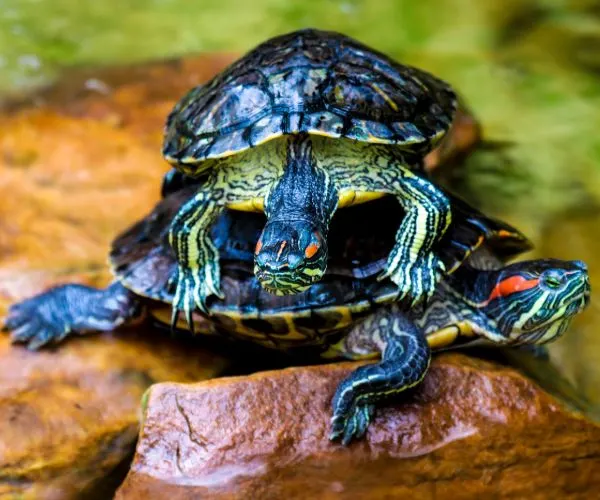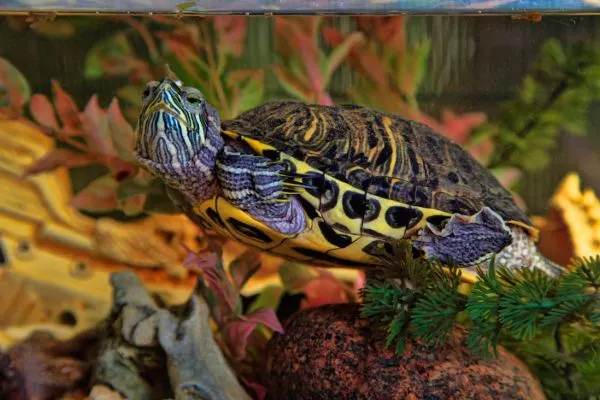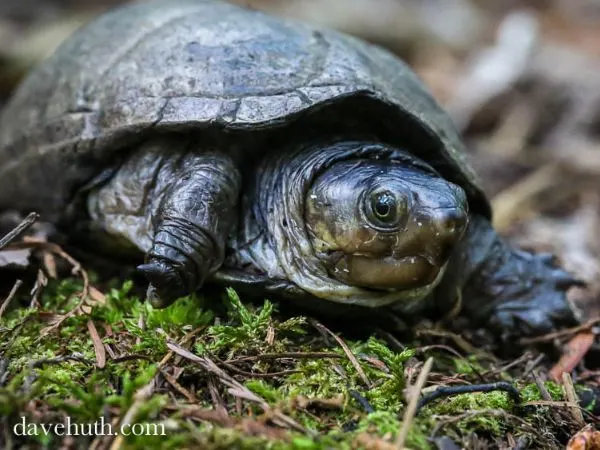The best turtles for ponds are those that come from the same climate and are therefore adapted to nature already.
Particularly, species of turtles like the western pond turtle, which are native to warmer climates, are a great addition to the backyard pond environment.
While indoor turtle tanks are the most popular way to house turtles, ponds work well too. In fact, they are the best way to house pet turtles. An outdoor pond offers a more natural habitat for the turtle.
Aquatic turtles can thrive in a pond setting, with natural sunlight helping to regulate their body temperature.
As such, a turtle kept in a pond is less stressed. While ponds have their advantages, they also have their challenges. Outdoor ponds also offers unlimited access to sunlight – which is the best source of UVA/UVB light.
This is essential for aquatic species such as the southern painted turtles and other water turtles which rely on these rays for healthy shell growth.
Ponds can also provide a source of food. Freshwater turtles can feed on aquatic weeds and consume deceased fish in the pond. In this way, turtles also benefit the pond ecosystem.
Moreover, a well-maintained turtle population in a pond can help control the aquatic vegetation and reduce the reliance on fish food.
One challenge you may face when choosing a water turtle for your pond is space or pond size. It’s a good idea to provide plenty of room and ensure the pond area has a shallow area for basking and a deep section at the bottom of the pond for the turtles to explore. Turtles require at least a 1000-gallon pond. As such, you’ll need a large yard. Secondly, such ponds can be costly to build.
Table of Contents
Freshwater turtles ideal for ponds
Before you decide to get a turtle for your pond, there are a few things to consider. Firstly as a pond owner, you need to consider the size of the pond. Turtles are best kept in large ponds.
Secondly, you might want to consider the size of the turtle. For those in suitable locations, the western pond turtle, requiring larger ponds with ample land area, can be a wise choice.
Small to medium-sized turtles are ideal as they require less space. It is also advisable to keep species native to your locale in the pond, that way if they do escape, they do not negatively affect the local ecosystem.
Subspecies such as red-eared sliders are invasive species and can negatively harm foreign habitats. Additionally, you won’t need to spend a lot on heating as the turtle lives in its native region.
Species like the western painted turtle, particularly those found along the west coast, are adapted to living in outdoor ponds and are a good idea for those living in their native range.
Some aquatic plants to have in the pond include pondweed, water lilies, frogbit, water hyacinth, and duckweed.
Later on, we will look at how to protect your precious turtles from predators. Keeping predators out can be more difficult than you’d imagine. Even in more urbanized areas, mammals such as raccoons can hunt your turtles.
It’s best bet to choose species that not only fit the pond environment but are also less likely to be threatened by potential predators, such as those with a hard shell.
Here some amazing species to consider for an outdoor pond.
Best Turtles For Ponds
1. Red-eared slider

The red-eared slider (Trachemys scripta elegans) is one of the most popular turtles kept as pets. This turtle is known as the red-eared slider because of the red streaks found on both sides of its head.
This hardy chelonian is perfect for ponds as it can thrive in all sorts of weather and temperatures. This pond slider is also known as the red-eared turtle, slider turtle, water slider turtle, and even as the red-eared terrapin.
Because of its hardiness, this chelonian can survive in just about any climate or ecosystem. This hardiness makes the species the most invasive turtle.
If you decide to keep the red-eared slider in a pond not located within its geographic range, make sure you don’t release it into the wild.
Creating a barrier with chicken wire around the pond can prevent escapes and protect your turtles from terrestrial habitats.
This can be detrimental to the local ecosystem. The native geographic range of the red-eared slider starts in Colorado and ends in Virginia and Florida.
The water temperature needs to be above 75 °F for most of the year. The red-eared slider will brumate once temperatures are below 50 °F.
Since they brumate at the bottom of ponds, the pond needs to be big enough so only the top freezes and not the entire pond.
A de-icer or floating heater to keep an air hole open as this facilitates the exchange of dissolved gases between the pond and the air.
2. Painted Turtle

The Chrysemys picta isn’t just a looker, it is also a suitable turtle for a freshwater pond. This freshwater chelonian is native to North America and has a huge geographic range.
They can be found from southern Canada all the way to northern Mexico. This makes them ideal for temperate regions. This turtle doesn’t require additional heating (except in winter, in some cases).
These turtles feed on aquatic plants, carrion, and small aquatic creatures such as small fish, and aquatic insects. You can easily provide edible aquatic plants and feeder fish in the pond for the painted turtles.
The temperature of the pond should be maintained above 70 °F most of the year.
The western painted turtle, part of the painted turtle species, is known for its striking red spots and is a resilient inhabitant for ponds in regions with varying temperatures.
There are four C. picta subspecies and these include eastern painted turtle (C. p. picta), midland painted turtle (C. p. marginata), southern painted turtle (C. p. dorsalis), western painted turtle (C. p. bellii).
The largest of the subspecies is the western painted turtle. This turtle grows to 10 inches and is endemic to southwestern Canada through Ontario to British Columbia.
The smallest Chrysemys picta subspecies is the southern painted turtle. This turtle grows to just 4-6 inches. This turtle can be found from southern Illinois and Missouri southwards.
The eastern painted turtle grows to about 6 inches and is probably the most popular painted turtle subspecies. This turtle can be found from Canada all the way south to Georgia.
The midland painted turtle is about the same size as the eastern painted turtle. This turtle is native to southern Ontario and Quebec all the way to Kentucky, Alabama, and Tennessee.
3. Northern Map Turtle

The northern map turtle (Graptemys geographica) is also known as the common map turtle.
This turtle is endemic to the eastern part of N. America (St. Lawrence River drainage basin in Canada & in the United States, they are found from eastern Minnesota to southern Wisconsin, from south Kansas to northeastern Oklahoma & Arkansas, and from Tennessee to northern Alabama & northwestern Georgia).
Adult female G. geographica grow to lengths of 7 to 10 inches while adult males grow to a length of 3.5 to 6.5 inches. As you can see, its size is very manageable.
This makes them an excellent pet turtle for your outdoor pond. The carapace of this chelonian is olive-brown with yellow stripes.
It is essential to have a floating turtle trap placed at the top of the trap, to ensure the safety of the turtle in the aquatic habitat.
The water temperature ideally should be between 72 to 76 °F for most of the year. As with other turtles mentioned, once the temperature drops below 50 °F, the turtle will hibernate.
G. geographica is omnivorous and feeds on aquatic plants such as pondweed, water lilies, frogbit, water hyacinth, and duckweed. They also eat feeder fish, krill, shrimps, worms (earthworms, bloodworms, crickets, and mealworms), and many more.
4. Yellow-bellied Slider

The yellow-bellied slider (Trachemys scripta scripta) is native to the southeastern part of the United States and as such needs to be kept in a pond where temperatures are above 75 °F.
These turtles are best kept in ponds located in places where the temperatures are a bit on the high side. The yellow-bellied slider’s geographic range stretches from southern Virginia to Florida.
Female specimens are larger than male specimens are. Females attain a length of 8 to 13 inches while males attain lengths of 5 to 9 inches. The T. s. scripta has a yellow plastron as well as yellow stripes on its carapace, limbs, and head.
The T. s. scripta is omnivorous and accepts a wide range of foods. You can feed them feeder fish, water snails, krill, worms such as mealworms, bloodworms, earthworms, roaches, and even locusts.
You can also feed them commercial turtle diets. In addition to this, they also eat aquatic plants and even leafy greens such as romaine lettuce and kale.
Unlike the red-eared slider, yellow-bellied sliders generally do not brumate (hibernate).
5. Common Snapping Turtle

The common snapping turtles (Chelydra serpentina) aren’t the easiest turtles to care for as they can be quite aggressive. In fact, these turtles are apex predators in their native habitats.
The C. serpentina can be found from Southern Alberta & Nova Scotia in Canada to the Gulf of Mexico and Texas. As you can see they have a wide geographic range.
When handled carelessly, common snapping turtles can deliver powerful bites. While this turtle can be kept in tanks, they are best housed in an outdoor garden pond.
The shell length of an adult C. serpentina is 7.87 to 17.72 inches. The C. serpentina has a long tail which is almost as long as its carapace. The carapace of this chelonian is dark in color. The limbs and necks have tubercles.
Snapping turtles eat feeder fish, krill, shrimps, crayfish, worms (earthworms, bloodworms, crickets, and mealworms), and even aquatic plants. They also accept commercial turtle food.
When temperatures are low enough the common snapping turtle will brumate.
6. Eastern Mud Turtle

The eastern mud turtle (Kinosternon subrubrum) is also called the common mud turtle. This turtle is quite popular among turtle enthusiasts. While they are quite small in size (3 to 4 inches), the eastern mud turtle can be quite aggressive.
These turtles will bite if provoked. The K. subrubrum will do just fine in an outdoor garden pond with temperatures above 70 °F. Mud turtles do brumate, so it’s important to keep that in mind.
If you don’t want the chelonian to brumate, then you need to bring it inside during the cold months. K. subrubrum is mostly carnivorous and accepts worms (superworms, earthworms, mealworms), crickets & other insects, raw lean beef, tilapia, chicken, feeder fish, shrimp, and krill.
They also accept commercial turtle diets. K. subrubrum also feeds on aquatic plants and algae.
The K. subrubrum is endemic to N. America specifically the southern United States but can be found across the eastern side of the United States in states such as Missouri, Kentucky, Tennessee, Arkansas, Mississippi, Illinois, Indiana, Louisiana, Maryland, New York, Pennsylvania, New Jersey, Delaware, Virginia, North Carolina, South Carolina, Oklahoma, Texas, Alabama, Georgia, and Florida.
7. European Pond Terrapin

The European pond terrapin (Emys orbicularis) is also known as the European pond turtle. As you may have already figured out the European pond terrapin is endemic to Europe in particular (southern and central Europe).
They can also be found in West Asia and North Africa. The European pond terrapin is known to live in the wetlands. For those living in Europe, this turtle is perfect for garden ponds since the importation of other turtles such as the red-eared slider is banned in several countries.
The European pond terrapin carapace length ranges from 5 to 15 inches (12 to 38 cm). Their shell is blackish with a greenish tint. The limbs and head of this turtle are dotted with yellow spots.
If we compare it to the spotted turtle, they have yellow spots on their shells which also look very stunning.
The European pond terrapin is omnivorous and accepts a wide variety of foods such as fish (trout, guppies, and smelt), mussels, dead flies, earthworms, snails, slugs, water insects, chicken, beef heart, turtle pudding, and even high-quality cat food (with fish/meat content of 60% and above).
They also accept dry turtle food. Plant matter to feed them includes water hyacinth, water lettuce, duckweed, pondweed, and many more.
It’s also an important element to create a safe haven for turtles, considering their role in the ecosystem, from commercial developments to private landowners, everyone has a stake in ensuring the health of the turtle population.
Natural predators
Turtles have several natural predators, and it’s your job to ensure they are well protected from them. Common predators include dogs, skunks, herons, raccoons, cats, rats, snakes, and birds of prey such as crows.
Raccoons are particularly crafty. These ingenious creatures can be tough to keep out. It is necessary to enclose the pond and its neighboring area with a wall or fence.
If you do fence off the pond with a wall, a dog stationed behind the walls can help ward off predators, especially raccoons. Just make sure the dog cannot jump over the wall and attack the turtles. A shock wire is also useful to deter predators, especially raccoons.
FAQs
What can you feed to turtles in a pond?
Outdoor pond turtles can eat a variety of things including commercial pellets, insects such as crickets, mosquitos, nats, fish (depending on the type, usually feeder fish), leafy greens, and plenty more. See our in-depth article about what turtles eat to learn about all the possibilities.
Can you put turtles in your koi pond?
It depends. If you have a large pond and house an aggressive turtle like a snapper, then the answer would be no. If you have smaller turtles like a musk turtle, mud turtle, or painted turtle then they will be ok.
What types of turtles can you put in your koi pond?
As mentioned above, smaller adult turtles will work so long as they are large enough the koi fish can’t swallow them whole. Cooters, pond sliders, painted turtles, and both mud and musk turtles should be fine. We don’t recommend softshell turtles since they can be aggressive as well.
Box turtles are not a type of turtle since these are terrestrial turtles, with the exception of the Coahuilan box turtle, also known as the aquatic box turtle.
What does a pond turtle need?
Outdoor pond turtles don’t require as much as indoor pond turtles. They need a large enough space to live and or cohabitate with other turtles and fish if you choose. They will need a way to easily get out of the water to be able to bask. Optionally you could have large stones or platforms in the middle.
Ideally, they should have half the pond in the sun and half in the shade. This gives them the option to bask in the sun and move to the shade to cool off.
Lastly, there should be something agitating the water to keep it oxygenated. Turtles can stay underwater and breathe through their cloaca (butts), but the water does need to have a way to regenerate the oxygen.
Can painted turtles live in a pond?
Painted turtles are some of the most common turtles found in ponds. They are a great turtle for an outdoor pond.
Conclusion
A pond is the best possible enclosure for freshwater turtle species. When choosing a turtle for your garden pond, it is best to go with turtles that are endemic to your locale.
However, if you wish to acquire a foreign turtle, ensure the temperatures and seasons of its native habitat are similar to yours, this can help you cut down heating costs.
Garden ponds can even have aquatic plants and feeder fish in them. Most small turtles can peacefully cohabitate with large fishes such as koi.
It’s important to consider access to shade and sun, water quality, aeration and filtration of the pond, protection from predators and kids, and pond winterization.
You need to decide if you will allow the turtles to submerge in the pond. If the turtles will be allowed to brumate in the pond, then you need to properly winterize the pond to facilitate this.
If you have any questions or information, leave us a comment.
